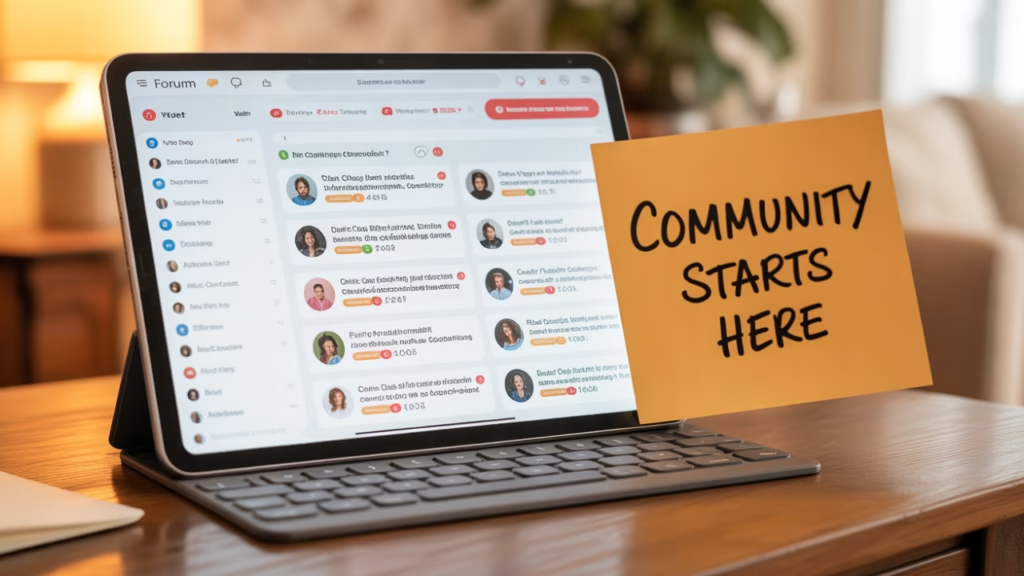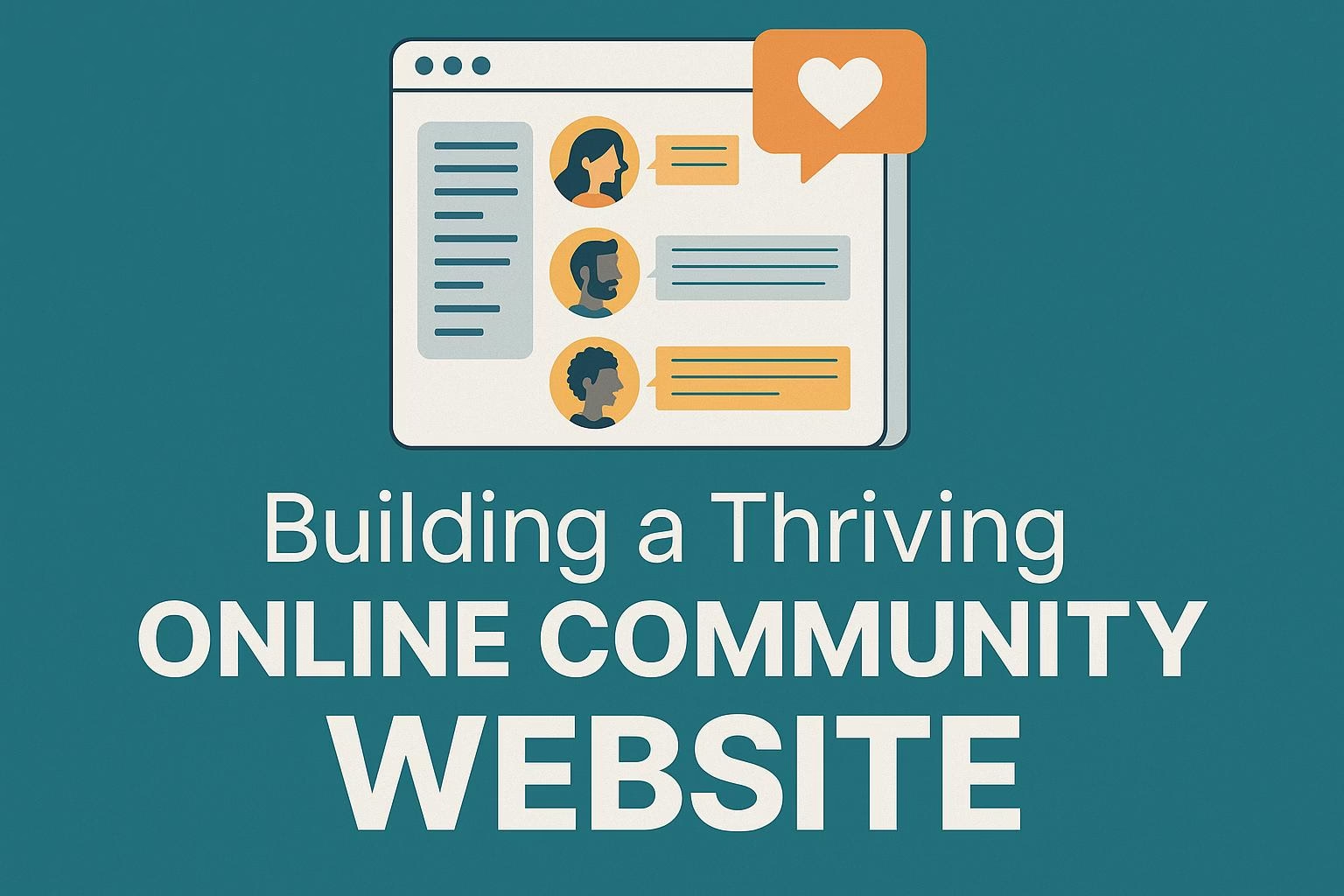But how do you create a thriving online community? What are the essential steps to make sure your site not only attracts visitors but keeps them engaged? In this article, we’ll explore the critical components of building an online community website that flourishes.
An online community is a group of people who interact with each other over the internet. They may share common interests, goals, or experiences. The purpose of an online community can vary from providing support and education to entertainment and social interaction.
The Importance of Online Communities

Online communities offer numerous benefits. They provide a platform for members to connect from anywhere in the world, breaking geographical barriers. This global reach allows for diverse perspectives and a wealth of knowledge that can be invaluable to members.
They also foster a sense of belonging and provide valuable resources and information that might not be accessible elsewhere. Members can find camaraderie and support, creating an environment where they feel understood and valued.
Moreover, they can be a powerful tool for brand building and customer loyalty for businesses. Companies can use online communities to engage with their customers, gather feedback, and build a loyal customer base. This direct interaction can lead to improved products and services, benefiting both the business and its community.
Types of Online Communities
Online communities come in various forms, each serving different purposes. Some communities are focused on support, providing a safe space for individuals to share their experiences and seek advice. Others are centered around education, offering tutorials, courses, and discussions to enhance members’ knowledge.
Social communities are designed for interaction and entertainment, allowing members to share content, engage in discussions, and participate in events. Professional communities cater to specific industries or careers, providing networking opportunities and career development resources. Understanding the type of community you want to create will help you better serve your audience.
Challenges in Building Online Communities
While online communities offer numerous benefits, they also come with challenges. Maintaining engagement can be difficult, especially as the community grows. It’s essential to keep content fresh and relevant to retain members’ interest.
Moderation is another challenge, requiring clear guidelines and active enforcement to ensure a respectful environment. Conflicts and disagreements can arise, and handling them effectively is crucial to maintaining a positive community atmosphere. Additionally, attracting new members while keeping existing ones engaged requires a strategic approach to marketing and community management.
Steps to Building Your Online Community Website

Step 1: Define Your Purpose
Before you start building, you need to have a clear understanding of your community’s purpose. Ask yourself the following questions:
- What is the main goal of your community?
- Who is your target audience?
- What value will your community provide to its members?
Defining your community’s purpose will guide your website’s design, features, and content.
Identify Your Community’s Niche
To define your community’s purpose, it’s crucial to identify your niche. What unique angle or topic will your community focus on? Consider the interests and needs of your target audience. A well-defined niche helps differentiate your community from others and attracts members who share specific interests.
Set Clear Objectives
Establish clear objectives for your community. What do you hope to achieve? Objectives could include increasing member engagement, providing educational resources, or fostering a support network. Clear objectives provide direction and allow you to measure your community’s success over time.
Understand Your Audience’s Needs
Understanding your audience’s needs is key to defining your community’s purpose. Conduct surveys, engage in discussions, and gather feedback to learn what your potential members are looking for. This information will help you tailor your community to meet their needs and provide value.
Step 2: Choose the Right Platform
Selecting the right platform is crucial. There are several community web builders available, such as WordPress, Ning, and Mighty Networks. Consider the following when choosing a platform:
- Ease of use: How user-friendly is the platform?
- Customization: Can you tailor the site to meet your community’s needs?
- Features: Does it offer essential features like forums, chat, and member profiles?
- Cost: Does it fit within your budget?
The right platform will make it easier to manage your community and provide a better experience for your members.
Evaluating Platform Features
When evaluating platforms, consider the features they offer. Look for platforms that support forums, chat, event hosting, and member directories. These features enhance interaction and engagement. Additionally, consider whether the platform offers integrations with other tools you might use, such as email marketing or analytics software.
Platform Scalability
Scalability is an important factor when choosing a platform. As your community grows, will the platform be able to accommodate increased traffic and activity? Ensure the platform can scale with your community to avoid disruptions and ensure a smooth user experience.
Assessing Technical Support
Technical support is crucial for resolving issues quickly. Evaluate the level of support the platform offers. Does it provide 24/7 support, live chat, or a comprehensive help center? Having access to reliable support can be invaluable, especially during the initial stages of building your community.
Step 3: Design with Your Audience in Mind
The design of your website should reflect your community’s purpose and appeal to your target audience. Here are some tips:
- Keep it simple: A clean, uncluttered design helps users navigate easily.
- Make it mobile-friendly: Ensure your website is responsive and looks great on all devices.
- Use visuals: Incorporate images and videos to make the site more engaging.
Prioritize User Experience
User experience (UX) should be a top priority in your design process. Consider how users will interact with your website and aim to make their experience seamless. Intuitive navigation, fast loading times, and clear calls to action are essential elements of good UX design.
Branding and Visual Identity
Your community website should reflect your brand’s identity. Choose a color scheme, typography, and imagery that align with your community’s values and message. Consistent branding helps create a cohesive and recognizable online presence, building trust and familiarity with your members.
Accessibility Considerations
Accessibility is vital to ensure all potential members can participate in your community. Implement features that make your website accessible to people with disabilities, such as alt text for images, keyboard navigation, and screen reader compatibility. An inclusive design shows that you value all members and their ability to engage with your community.
Step 4: Create Engaging Content
Content is king when it comes to online communities. It’s what keeps members coming back. Here are some content ideas:
- Blog posts: Share articles on relevant topics to spark discussion.
- Forums: Allow members to ask questions and share knowledge.
- Events: Host webinars or live chats to engage members in real-time.
- Newsletters: Keep members informed with regular updates.
Developing a Content Strategy
A content strategy is essential for creating engaging content consistently. Plan your content calendar, considering the topics that interest your audience and the type of content that will engage them. Balance evergreen content with timely pieces to keep your community informed and entertained.
Encouraging Member Contributions
Encourage members to contribute content to the community. User-generated content, such as forum posts, articles, and event suggestions, can enrich your community and foster a sense of ownership among members. Recognize and reward contributions to motivate ongoing participation.
Leveraging Multimedia Content
Incorporate multimedia content to enhance engagement. Videos, podcasts, and interactive elements can make content more dynamic and appealing. Multimedia content caters to different learning styles and keeps your community vibrant and engaging.
Step 5: Foster Interaction and Engagement
An active community is an engaged community. Encourage interaction by:
- Prompting discussions with questions and polls.
- Recognizing active members and rewarding contributions.
- Hosting challenges or contests to increase participation.
Building a Welcoming Culture
Fostering a welcoming culture is crucial for encouraging interaction. Create an environment where members feel comfortable sharing their thoughts and ideas. Set a positive tone, promote inclusivity, and address any negativity promptly to maintain a supportive community atmosphere.
Implementing Gamification
Gamification can boost engagement by making participation fun and rewarding. Implement badges, points, or leaderboards to motivate members to interact more. Gamification taps into members’ competitive spirit and encourages continued involvement.
Facilitating Networking Opportunities
Provide opportunities for members to network and connect with each other. Virtual meetups, discussion groups, and collaborative projects can strengthen community bonds. Networking fosters a sense of belonging and can lead to valuable collaborations and friendships.
Step 6: Monitor and Moderate
To maintain a healthy community, you need to monitor activity and moderate content. Establish clear guidelines for behavior and enforce them consistently. This helps create a safe and respectful environment for all members.
Setting Community Guidelines
Clear community guidelines set the tone for acceptable behavior. Define rules regarding conduct, content sharing, and conflict resolution. Communicate these guidelines to all members and ensure they are easily accessible on your website.
Active Moderation Strategies
Active moderation involves regularly monitoring discussions and intervening when necessary. Designate moderators who can address issues promptly and fairly. Encourage members to report inappropriate content, ensuring a safe and respectful community environment.
Gathering and Acting on Feedback
Regularly gather feedback from members to understand their experiences and identify areas for improvement. Use surveys, polls, and feedback forms to collect insights. Act on this feedback to make necessary adjustments and enhance the community experience.
Promoting Your Online Community

Utilize Social Media
Leverage social media platforms to promote your community. Share updates, engage with potential members, and create a buzz around your community’s activities.
Creating Engaging Social Content
Develop engaging content specifically for social media. Use eye-catching visuals, compelling captions, and interactive elements like polls or quizzes. Tailor your content to each platform’s unique audience and format to maximize reach and engagement.
Building a Social Media Strategy
A comprehensive social media strategy can amplify your community’s reach. Plan your posting schedule, identify key platforms, and set measurable goals. Consistent and strategic social media activity helps attract new members and keep existing ones engaged.
Engaging with Your Social Audience
Engagement is key to building a strong social media presence. Respond to comments, messages, and mentions promptly. Encourage discussions and actively participate in conversations related to your community’s niche to build rapport and trust with your audience.
Collaborate with Influencers
Partnering with influencers in your niche can help you reach a larger audience. They can introduce your community to their followers and lend credibility to your site.
Identifying the Right Influencers
Identify influencers whose values and audience align with your community. Look for influencers with genuine engagement and a strong connection with their followers. Collaborating with the right influencers can enhance your community’s credibility and attract like-minded members.
Structuring Influencer Partnerships
Define the goals and structure of your influencer partnerships. Whether it’s guest posts, co-hosted events, or social media takeovers, ensure the collaboration benefits both parties. Clear communication and mutual respect are key to successful influencer partnerships.
Measuring Influencer Impact
Measure the impact of influencer collaborations by tracking key metrics, such as website traffic, membership growth, and engagement levels. Use these insights to refine your influencer strategy and maximize the benefits of future partnerships.
SEO Optimization
Optimize your community website for search engines. Use relevant keywords like “online community” and “community website” naturally in your content. This will help increase visibility and attract more members.
Conducting Keyword Research
Conduct thorough keyword research to identify terms your target audience is searching for. Use tools like Google Keyword Planner or SEMrush to find relevant keywords with a balance of search volume and competition. Incorporating these keywords strategically into your content can boost your site’s visibility.
On-Page SEO Techniques
Implement on-page SEO techniques to enhance your website’s search engine rankings. Optimize meta tags, headings, and image alt text with relevant keywords. Ensure your site has a clear structure, with internal links to guide users and search engines through your content.
Monitoring SEO Performance
Regularly monitor your website’s SEO performance using analytics tools like Google Analytics and Search Console. Track metrics such as organic traffic, bounce rate, and keyword rankings. Use this data to identify areas for improvement and refine your SEO strategy.
Measuring Success and Making Improvements

Regularly assess your community’s performance. Use analytics tools to track user engagement, membership growth, and content popularity. Based on your findings, make necessary adjustments to improve the user experience and keep the community thriving.
Analyzing Community Metrics
Collect and analyze key metrics to understand your community’s performance. Track metrics such as active members, engagement rates, content views, and event participation. These insights provide a comprehensive view of your community’s health and areas for growth.
Implementing Feedback Loops
Establish feedback loops to continuously gather insights from your community. Encourage members to share their thoughts and suggestions regularly. Use this feedback to make data-driven decisions and implement improvements that align with your community’s needs.
Adapting to Member Needs
Remain adaptable to the evolving needs of your community. As your community grows, member interests and preferences may change. Stay attuned to these shifts and adjust your content, features, and engagement strategies accordingly to keep your community relevant and thriving.
Conclusion

Building a thriving online community website takes time, effort, and dedication. By understanding your audience, choosing the right platform, and fostering engagement, you can create a vibrant space where members feel valued and connected. Remember, a successful community is one that evolves with its members, continually providing value and encouraging meaningful interactions.
Now is the time to embark on your journey of building an online community that stands out and leaves a lasting impact. Good luck!

